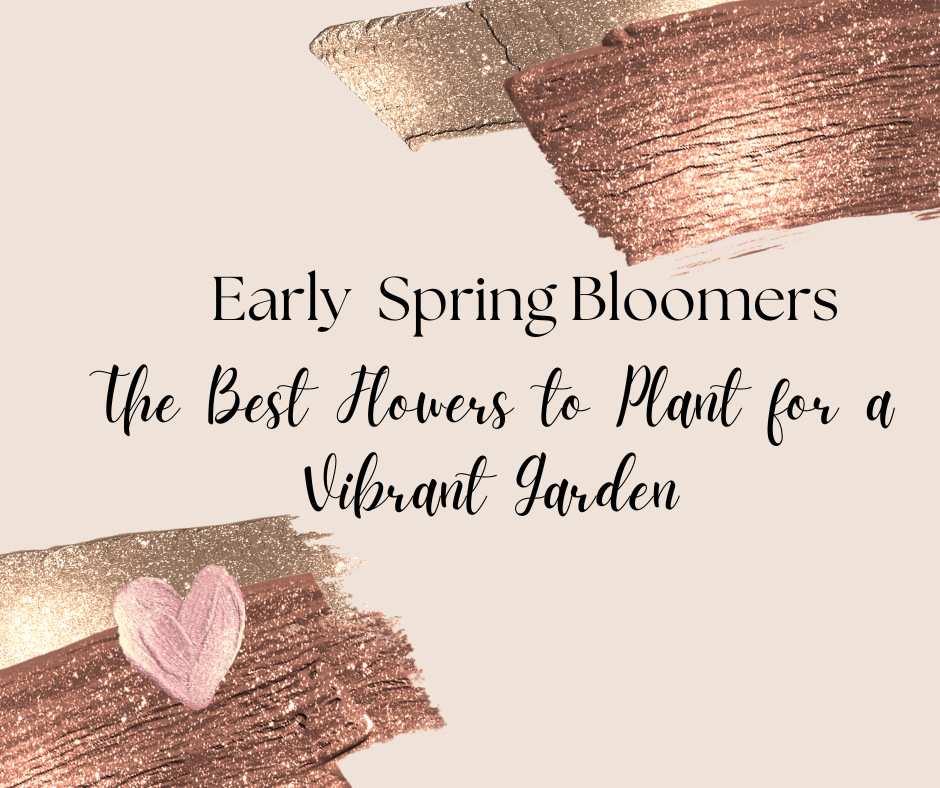When winter ends and the snow melts, flowers begin to grow. These are called early spring bloomers. They are the first flowers to show up in the garden when it starts getting warm.
These flowers are special because they bring color and joy after the cold months. They also help bees and butterflies by giving them food. In this blog, you will learn which flowers bloom early, how to take care of them, and fun new tips to make your garden look amazing.
Why Choose Early Blooming Flowers for Your Garden?
Early blooming flowers are a gardener’s best friend for several reasons. Firstly, they signal the end of winter and the beginning of the growing season, lifting spirits with their colorful display. These flowers also help fill the gap between winter and the full bloom of late spring and summer flowers. Additionally, early bloomers are crucial for supporting the first pollinators of the year, such as bees and butterflies, providing them with much-needed nectar and pollen.
Top 10 Early Spring Blooming Flowers
- Snowdrops :
Snowdrops (Galanthus) are often the first flowers to emerge in late winter or early spring. Their delicate white blooms are a welcome sight, signaling that warmer days are on the way. Snowdrops are easy to grow and prosper in well-drained soil and partially shaded areas.
- Crocuses:
Crocuses (Crocus spp.) are small, cup-shaped flowers that come in various colors, including purple, yellow, and white. These hardy bulbs are among the earliest to bloom, often pushing through the snow. Crocuses flourish in sunny spots and well-drained soil.
- Daffodils:
Daffodils (Narcissus) are a classic spring flower known for their bright yellow or white trumpet-shaped blooms. They are simple to cultivate and naturalize effectively, allowing them to spread and reappear annually. Daffodils flourish in areas with full sun to partial shade and in well-drained soil.
- Tulips
Tulips (Tulipa) are beloved for their wide range of colors and shapes. These popular spring bulbs are easy to plant and care for, making them a favorite among gardeners. Tulips prefer full sun and well-drained soil and should be planted in the fall for a spring display.
- Hyacinths
Hyacinths (Hyacinthus) are known for their dense, fragrant flower spikes in shades of blue, pink, purple, and white. These early bloomers add a burst of color and scent to the garden. Hyacinths thrive in full sun to partial shade and require well-drained soil.
- Hellebores
Hellebores (Helleborus), also known as Lenten roses, are hardy perennials that bloom in late winter to early spring. Their nodding, cup-shaped flowers come in a variety of colors, including white, pink, and purple. Hellebores thrive in partial to full shade and well-drained, rich soil.
- Forsythia
Forsythia (Forsythia spp.) is a deciduous shrub known for its bright yellow flowers that bloom in early spring before the leaves emerge. This fast-growing shrub prefers full sun and well-drained soil and can be pruned to maintain shape and size.
- Pansies
Pansies (Viola tricolor) are versatile annuals known for their cheerful, face-like blooms in a wide range of colors. They are hardy and can withstand light frosts, making them ideal for early spring planting. Pansies prefer full to partial sun and well-drained soil.
- Primroses
Primroses (Primula spp.) are early bloomers with clusters of vibrant flowers in colors like yellow, pink, red, and purple. These perennials thrive in cool, moist conditions and prefer partial shade and well-drained soil.
- Anemones
Anemones (Anemone spp.), also known as windflowers, are charming early spring bloomers with daisy-like flowers in shades of white, pink, purple, and blue. They favor partial shade and require well-drained soil.
Climate-Specific Early Spring Bloomers
Not all flowers grow well in every place. Some need cold winters, while others like warmer weather. Picking the right early bloomers for your climate will help your garden grow strong and healthy.
If you live in a cold area (Zone 3–5), try planting snowdrops, crocuses, and hellebores. They love chilly weather and bloom even when it’s still cold outside.
In mild to warm places (Zone 6–9), you can grow camellias, flowering quince, and Virginia bluebells. These flowers like soft winters and warm early springs.
No matter where you live, try planting native flowers. These are plants that grow naturally in your area. They are easier to care for and help local bees and butterflies feel at home.
How to Plant and Care for Early Spring Flowers
Planting early spring bloomers is relatively straightforward, but there are a few key steps to ensure success. First, choose a location with the appropriate light and soil conditions for each plant. Most early bloomers thrive in well-drained soil and a location with sufficient sunlight, although some, such as hellebores, do well in shaded areas.
When planting bulbs, such as daffodils, tulips, and crocuses, it’s essential to plant them in the fall before the ground freezes. Dig a hole three times the height of the bulb, place the bulb with the pointed end up, and cover with soil. Water thoroughly after planting.
For perennials like hellebores and primroses, plant them in the spring or fall. Dig a hole large enough to accommodate the root ball, place the plant in the hole, and fill with soil. Water thoroughly and use mulch to maintain moisture and prevent weeds.
Regular watering is crucial, especially during dry spells, but avoid waterlogging the soil. Fertilize with a balanced, slow-release fertilizer in early spring to promote healthy growth and blooms. Deadhead spent flowers to encourage more blooms and prevent the plants from going to seed prematurely.
Designing Your Garden with Early Spring Bloomers
Designing a garden with early spring bloomers involves strategic planning to create a harmonious and visually appealing landscape. Start by considering the bloom times and colors of the flowers you choose. Aim for a mix of colors and staggered bloom times to ensure continuous color throughout the early spring season.
Incorporate different heights and textures to add interest to your garden. For example, plant taller daffodils and tulips towards the back of flower beds, with shorter crocuses and snowdrops in the front. Use shrubs like forsythia as focal points or background plants to provide structure.
Combine early bloomers with evergreen plants and early-flowering shrubs to create a cohesive look. Consider planting groundcovers, such as creeping thyme or ajuga, to fill in gaps and provide a lush backdrop for your spring flowers.
Best Companion Plants for Early Spring Bloomers
Pairing the right plants together helps your garden grow better and look more beautiful. This is called companion planting. When early spring flowers grow next to helpful plants, they stay healthy and bright longer.
For example, daffodils help keep animals like mice and squirrels away from tulips. They don’t like the smell of daffodils! You can also plant creeping phlox or ajuga around your flowers. These groundcovers stay green and fill in empty spots, so your garden looks full and colorful.
If you plant hellebores, try adding some ferns nearby. Their soft green leaves make the flowers stand out. You can also mix in grape hyacinths with your crocuses to get a mix of colors and shapes.
Choosing the right plant buddies means your flowers will be safer, stronger, and even prettier.
Eco-Friendly Ways to Boost Early Spring Blooms
Want your spring flowers to bloom big and bright—without hurting nature? Here are some eco-friendly tips that are good for your garden and the Earth.
Instead of using chemical fertilizers, feed your plants with compost tea or worm castings. These natural boosters give your soil healthy nutrients.
You can also collect rainwater in barrels and use it to water your flowers. This saves clean water and helps your plants feel more natural.
For bugs, don’t spray harmful sprays. Plant marigolds, alliums, or lavender nearby. These flowers help keep away pests like aphids and slugs.
Gardening with love for nature means your blooms stay healthy—and the Earth stays happy too!
Common Problems and Solutions for Early Spring Bloomers
While early spring bloomers are generally hardy, they can face some common issues. Here are several issues and their corresponding solutions:
- Frost Damage: Cover plants with frost cloths or bring potted plants indoors during unexpected frosts.
- Poor Drainage:Ensure soil is well-drained to prevent bulb rot and fungal diseases.
- Pests:Use organic pest control methods, such as neem oil or insecticidal soap, to manage pests.
- Lack of Blooms: Ensure plants receive adequate sunlight and nutrients, and avoid overcrowding.
Conclusion
Early spring flowers are like little gifts from nature. They make the garden bright and happy when winter goes away.
By choosing the right flowers and taking care of them, your garden will grow strong and beautiful. These flowers also help the bees and bugs. So plant early bloomers and enjoy the colors of spring every year!
FAQs
Q1: What are early spring bloomers? Early spring bloomers are flowers that grow at the very start of spring. Some even grow while snow is still on the ground!
Q2: Why are early bloomers important? They make gardens pretty after winter and give food to bees and butterflies who wake up early.
Q3: When should I plant them? Most early flowers grow from bulbs you plant in the fall. Some can be planted in early spring too.
Q4: Do they need lots of care? No, they are easy to grow! Just give them sunlight, good soil, and a little water.
Q5: Can I grow them in pots? Yes! Flowers like tulips and crocuses can grow in pots on your porch or balcony.

I’m Emma Rose, the founder of tryhardguides.co.uk, and a content creator with a passion for writing across multiple niches—including health, lifestyle, tech, career, and personal development. I love turning complex ideas into relatable, easy-to-digest content that helps people learn, grow, and stay inspired. Whether I’m sharing practical tips or diving into thought-provoking topics, my goal is always to add real value and connect with readers on a deeper level.
Discover more from Try Hard Guides
Subscribe to get the latest posts sent to your email.

